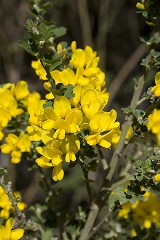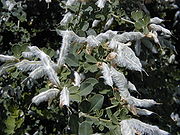
French Broom
Encyclopedia
Genista monspessulana also known as French Broom, Cape Broom and Montpellier Broom, is a woody perennial
shrub
and a legume. The species is native to the Mediterranean region, and is considered an invasive plant in most places where it has been introduced.
are evergreen
, trifoliate with three narrow obovate leaflets, 1–2 cm long. The flower
s are yellow, grouped 3-9 together in short raceme
s. Like other legumes
, it develops its seeds within a pod. The pods are 2–3 cm long, tough and hard, and are transported easily by flowing water and animals. They burst open with force, dispersing the seeds several metres. The plant begins seed production once it reaches a height of approximately 40 cm, and each plant can live for 10–20 years. One mature plant can produce 10,000 seeds per season. The generous seed production and the plant's ability to re-sprout after cutting or burning help it to invade new habitat vigorously when introduced.
It is related to the Common Broom and Spanish Broom
. This suite of plants is common in European shrubland
s. French Broom was originally distributed throughout Mediterranean Europe
and northwest Africa
, the Azores
, and the Canary Islands
. Due to its lower tolerance for frost
than other broom species, it is common in warmer, lower elevation areas. It is found on coastal strips and in sunny inland areas, and does best with plentiful rainfall and sandy soils.

s make it a very successful species in California
and the Pacific Northwest
, where it is considered a severe noxious weed, covering over 40,000 hectare
s. It is even more widespread in Australia, where it covers 600,000 hectares and is also considered a noxious weed.
The plant often outcompetes native vegetation, forming dense fields where other species are almost completely crowded out. Stands of French broom can be so thick that they make meadows and pastures useless for wild and domestic animals. Other harmful effects include its ability to shade out tree seedlings in reforested areas, its tendency to catch fire, and the toxicity of its leaves and seeds, which contain alkaloid
s poisonous to many large domestic animals.
Perennial plant
A perennial plant or simply perennial is a plant that lives for more than two years. The term is often used to differentiate a plant from shorter lived annuals and biennials. The term is sometimes misused by commercial gardeners or horticulturalists to describe only herbaceous perennials...
shrub
Shrub
A shrub or bush is distinguished from a tree by its multiple stems and shorter height, usually under 5–6 m tall. A large number of plants may become either shrubs or trees, depending on the growing conditions they experience...
and a legume. The species is native to the Mediterranean region, and is considered an invasive plant in most places where it has been introduced.
Description
French Broom, Genista monspessulana, grows to 1-2.5 m tall, with slender green branches. The leavesLeaf
A leaf is an organ of a vascular plant, as defined in botanical terms, and in particular in plant morphology. Foliage is a mass noun that refers to leaves as a feature of plants....
are evergreen
Evergreen
In botany, an evergreen plant is a plant that has leaves in all seasons. This contrasts with deciduous plants, which completely lose their foliage during the winter or dry season.There are many different kinds of evergreen plants, both trees and shrubs...
, trifoliate with three narrow obovate leaflets, 1–2 cm long. The flower
Flower
A flower, sometimes known as a bloom or blossom, is the reproductive structure found in flowering plants . The biological function of a flower is to effect reproduction, usually by providing a mechanism for the union of sperm with eggs...
s are yellow, grouped 3-9 together in short raceme
Raceme
A raceme is a type of inflorescence that is unbranched and indeterminate and bears pedicellate flowers — flowers having short floral stalks called pedicels — along the axis. In botany, axis means a shoot, in this case one bearing the flowers. In a raceme, the oldest flowers are borne...
s. Like other legumes
Fabaceae
The Fabaceae or Leguminosae, commonly known as the legume, pea, or bean family, is a large and economically important family of flowering plants. The group is the third largest land plant family, behind only the Orchidaceae and Asteraceae, with 730 genera and over 19,400 species...
, it develops its seeds within a pod. The pods are 2–3 cm long, tough and hard, and are transported easily by flowing water and animals. They burst open with force, dispersing the seeds several metres. The plant begins seed production once it reaches a height of approximately 40 cm, and each plant can live for 10–20 years. One mature plant can produce 10,000 seeds per season. The generous seed production and the plant's ability to re-sprout after cutting or burning help it to invade new habitat vigorously when introduced.
It is related to the Common Broom and Spanish Broom
Spanish Broom
Spartium junceum , known as Spanish Broom or Weaver's Broom, is a perennial, leguminous shrub native to the Mediterranean region in southern Europe, southwest Asia and northwest Africa, where it is found in sunny sites, usually on dry, sandy soils...
. This suite of plants is common in European shrubland
Shrubland
Shrubland, scrubland, scrub or brush is a plant community characterized by vegetation dominated by shrubs, often also including grasses, herbs, and geophytes. Shrubland may either occur naturally or be the result of human activity...
s. French Broom was originally distributed throughout Mediterranean Europe
Europe
Europe is, by convention, one of the world's seven continents. Comprising the westernmost peninsula of Eurasia, Europe is generally 'divided' from Asia to its east by the watershed divides of the Ural and Caucasus Mountains, the Ural River, the Caspian and Black Seas, and the waterways connecting...
and northwest Africa
Africa
Africa is the world's second largest and second most populous continent, after Asia. At about 30.2 million km² including adjacent islands, it covers 6% of the Earth's total surface area and 20.4% of the total land area...
, the Azores
Azores
The Archipelago of the Azores is composed of nine volcanic islands situated in the middle of the North Atlantic Ocean, and is located about west from Lisbon and about east from the east coast of North America. The islands, and their economic exclusion zone, form the Autonomous Region of the...
, and the Canary Islands
Canary Islands
The Canary Islands , also known as the Canaries , is a Spanish archipelago located just off the northwest coast of mainland Africa, 100 km west of the border between Morocco and the Western Sahara. The Canaries are a Spanish autonomous community and an outermost region of the European Union...
. Due to its lower tolerance for frost
Frost
Frost is the solid deposition of water vapor from saturated air. It is formed when solid surfaces are cooled to below the dew point of the adjacent air as well as below the freezing point of water. Frost crystals' size differ depending on time and water vapour available. Frost is also usually...
than other broom species, it is common in warmer, lower elevation areas. It is found on coastal strips and in sunny inland areas, and does best with plentiful rainfall and sandy soils.

Invasiveness
When introduced to a new area, French Broom can become an invasive plant. Its reproductive vigour and preference for Mediterranean climateMediterranean climate
A Mediterranean climate is the climate typical of most of the lands in the Mediterranean Basin, and is a particular variety of subtropical climate...
s make it a very successful species in California
California
California is a state located on the West Coast of the United States. It is by far the most populous U.S. state, and the third-largest by land area...
and the Pacific Northwest
Pacific Northwest
The Pacific Northwest is a region in northwestern North America, bounded by the Pacific Ocean to the west and, loosely, by the Rocky Mountains on the east. Definitions of the region vary and there is no commonly agreed upon boundary, even among Pacific Northwesterners. A common concept of the...
, where it is considered a severe noxious weed, covering over 40,000 hectare
Hectare
The hectare is a metric unit of area defined as 10,000 square metres , and primarily used in the measurement of land. In 1795, when the metric system was introduced, the are was defined as being 100 square metres and the hectare was thus 100 ares or 1/100 km2...
s. It is even more widespread in Australia, where it covers 600,000 hectares and is also considered a noxious weed.
The plant often outcompetes native vegetation, forming dense fields where other species are almost completely crowded out. Stands of French broom can be so thick that they make meadows and pastures useless for wild and domestic animals. Other harmful effects include its ability to shade out tree seedlings in reforested areas, its tendency to catch fire, and the toxicity of its leaves and seeds, which contain alkaloid
Alkaloid
Alkaloids are a group of naturally occurring chemical compounds that contain mostly basic nitrogen atoms. This group also includes some related compounds with neutral and even weakly acidic properties. Also some synthetic compounds of similar structure are attributed to alkaloids...
s poisonous to many large domestic animals.
External links
- USDA Genista monspessulana - French Broom Information Page
- French Broom Webpage from the Calflora.org website; the webpage gives links to additional photos. Retrieved May 17, 2007.
- Genista monspessulans (French Broom), from The Global Invasive Species Initiative website; the webpage has links to several photographs. Retrieved May 19, 2007.

